Heavy fighting vehicle of flamethrowers BMO-T
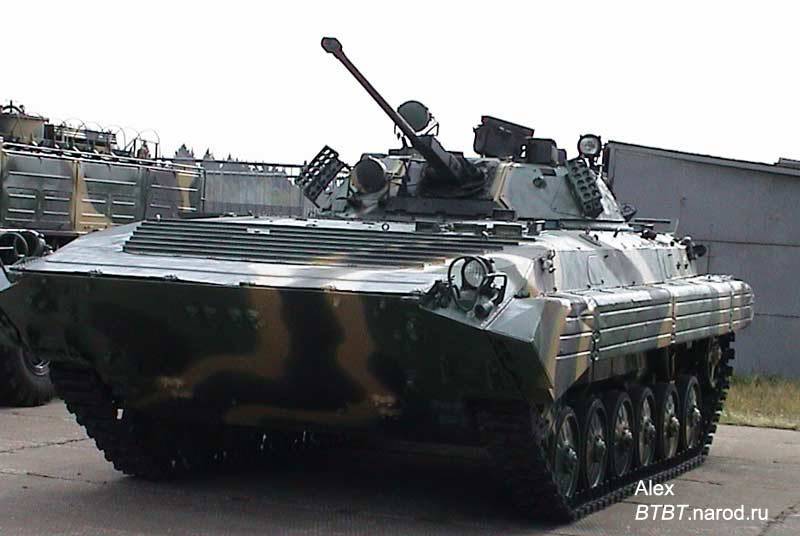
The heavy armored infantry vehicle of the Armath family will be the first vehicle of this class delivered to the Russian armed forces. Nevertheless, since the beginning of the two thousand years, our army has a heavy fighting machine of the BMO-T flamethrowers (the project “Object 564”), which under certain reservations can be considered an analogue of the Armata infantry fighting vehicle. The fact is that the term “combat vehicle of flame throwers” refers to a special kind of infantry fighting vehicle adapted for solving certain tasks. First of all, the combat vehicle of flamethrowers differs in its purpose: such equipment is not built for infantry, but for personnel of the RCBZ troops. In addition, the state-of-the-art equipment should not carry anti-tank grenade launchers, but jet flamethrowers. In the combat or airborne compartment of such a machine, additional stowage should be provided for the transport of such weapons.
Thus, the BMO-T combat vehicles available in the Russian armored brigade forces can be considered heavy infantry fighting vehicles, which have some specific features. In the context of the discussion of the Armata project, the BMO-T vehicle is of particular interest since it is built on the basis of the existing tank chassis. The basis for this machine was the main battle tank T-72. As conceived by the authors of the project, such a base was to provide a high level of protection and the possibility of combat work in the same order as tanks.
The main task of the BMO-T machine is the transportation and fire support of flamethrowers. Such a technique can be used as a highly protected vehicle suitable for use on the front edge. A characteristic feature of the BMO-T, associated with the intended use, is a set of stacks in the troop compartment, in which it is proposed to transport a large number of rocket flamethrowers. Thus, the crew and landing BMO-T can attack manpower, equipment and enemy fortifications, using several types of small arms, as well as using more serious systems.
In order to simplify the construction of new technology, the main tank T-72 was chosen as the basis for the BMO-T. When converting a serial tank into a fighting machine, flamethrowers were asked to dismantle some units and replace them with new ones. At the same time, part of the units and assemblies should have remained unchanged. So, the BMO-T "inherits" the engine and transmission, running gear and some other systems of the base tank.
The hull has undergone the most noticeable changes. Instead of a native roof with a shoulder strap on it, it was proposed to install a special armored superstructure of a polygonal shape. The front part of this superstructure is a continuation of the inclined upper frontal detail of the base tank and, apparently, has a similar design. At the bottom of the superstructure forehead provides a rectangular recess located above the hatch of the driver. To preserve the required level of protection, a special triangular-shaped construction is mounted on the hatch, which, when the hatch is closed, “fills” a recess in the frontal part. Upper frontal parts of the hull and superstructure of the BMO-T machine are covered with dynamic protection.
From the sides, the crew and landing force are protected by spaced booking. Its inner sheets are a continuation of the hull sides of the tank, and the outer ones are mounted on the fences, directly above the side screens. Between the external and internal side sheets of the superstructure, volumes are provided for the placement of fuel tanks, some equipment and various assets. Double sides cover not only the habitable volume, but also some space above the roof of the engine compartment. The rear cut side of the "boxes" is at the stern of the hull. It is assumed that such a layout of the modified armored hull should provide additional protection for the landing force.
When the tank was converted into a flamethrower combat vehicle, only the hull design underwent major changes. Its layout has changed in accordance with the purpose of the machine. In the front part there is still the workplace of the driver, the middle part is given for the placement of troops and weapons, and in the stern are the units of the power plant. Preserving the overall layout of the hull to some extent facilitated the development of the new BMO-T machine, but it affected some aspects of operation, primarily, the convenience of landing and disembarking.
According to reports, the machine BMO-T is equipped with a multi-fuel engine B-84-1 or B-84M power up to 840 hp. The engine and other units of the power plant are unchanged borrowed from the base tank. Thus, the engine is equipped with a two-stage (cyclone apparatus and filters) air cleaner, air and electric starting systems. Torque is transmitted to the drive wheels through a mechanical transmission with a step-up gear, side gearboxes, etc. equipment. The transmission has 7 forward gears and 1 reverse gears. The fuel system has undergone major changes. In front of the hull there is a fuel tank with a capacity of 347 l, in the side boxes of the hull there are four more tanks on the 961 l.
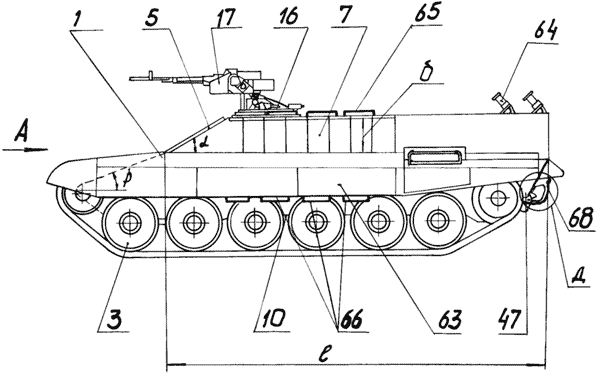
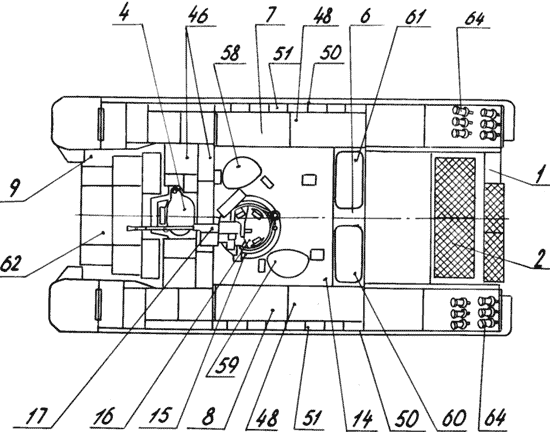
General view of the LMC-T
1 - T-72 Tank Base Chassis
2 - engine compartment
3 - Chassis
4 - driver's door
5 - superstructure front wall
6 - rear sloping wall of the superstructure
7 - right wall of the superstructure
8 - the left wall of the superstructure
9 - frontal front sheets
10 - bottom
11 - starboard
12 - port side
13 - motor partition
14 - Roof
15 - Commander's Turret
16 - hatch
17 - anti-aircraft machine gun with remote control
Inhabited compartment and ammunition
18 - Commander's Seat Brackets
19 - Commander's Seat
20 - driver's seat
21, 22, 23, 24 - flamethrower seats on the starboard
25, 26, 27 - flamethrower seats on the left side
28, 29, 30 - ammunition flamethrowers
31 - RPO launch pipes
32 - top longitudinal beam
33 - lower longitudinal beam
34 - bolted
35 - bounding brackets
36 - eyelets
37 - longitudinal holes
38 - locking restrictive covers
39 - cylindrical tubes
40 - longitudinal through groove
41 - axis
42 - Springs
43 - pens
44 - Mounts
45 - Pallet
46 - dynamic protection armored
47 - aft hull sheet
48 - frame top wall
49 - bottom wall
50 - longitudinal side walls
51 - dynamic side protection
52, 53 - fuel tanks
54 - filtering unit
55 - rechargeable batteries
56 - Start-up equipment
57 - additional ammunition flamethrowers
58, 59 - deck hatches
60, 61 - sealed armor doors that open up to the side of the nose of the car
62 - VLD dynamic protection
63 - side screens
64 - Smoke Curtain Launch Systems
65 - Handrails
66 - footboards
67 - Springs
68 - spring loaded steps
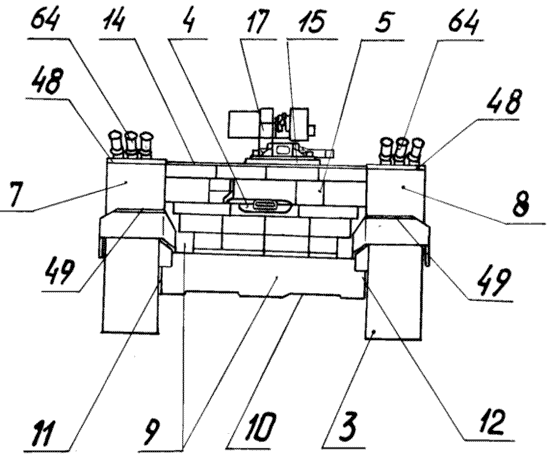
The chassis of the BMO-T fully repeats the corresponding units of the T-72 tank. It includes six track rollers, front guide and rear drive wheels, as well as three support rollers on each side. Suspension - individual torsion bar, rollers have external shock absorption. The 1,2 and 5 pairs of road wheels are equipped with additional hydraulic shock absorbers. Like the base tank, the BMO-T is equipped with a metal caterpillar with a metal or rubber-metal joint.
The BMO-T, based on the aggregates of the T-72 tank, has similar dimensions and mobility indicators. The combat weight of the flamethrower machine is 43,9 m. The total length is about 7,2 m, the width is 3,8 m, and the height is less than 2,3 m. Thanks to the used power plant, the machine can reach speeds of up to 60 km / h and travel at a single fuel station to 710 km. Other mobility characteristics remained at the level of the base T-72. A BMO-T can climb an 30-degree slope or a wall with a height of 85 cm. It is possible to cross a moat up to 2,7 m wide and ford 1,2 m deep.
The main task of the BMO-T combat vehicle is the transportation of the flamethrower department, which affected a large number of its features. So, the car received the weapon, peculiar to modern armored personnel carriers. In front of the roof of the hull provides a hatch with a remotely controlled machine gun turret, on which is mounted a heavy machine gun NSV. Additional armament consists of 12B “Cloud” smoke grenade launchers. In different photographs, various types of BMO-T carry such weapons both in the stern, on the side boxes, and on the front sheet. As far as is known, mass-produced cars are equipped with grenade launchers mounted above the front fenders of the tracks, in groups of 902 pieces.
A characteristic feature of the modifications of the armored hull is a change in the placement of some units. According to reports, part of the equipment was placed on fences and placed between the side reservation sheets. Thanks to this, it was possible to free up additional volumes inside the habitable compartment. As a result, it became possible to accommodate not only the crew and troops, but also a sufficiently large amount of weapons.
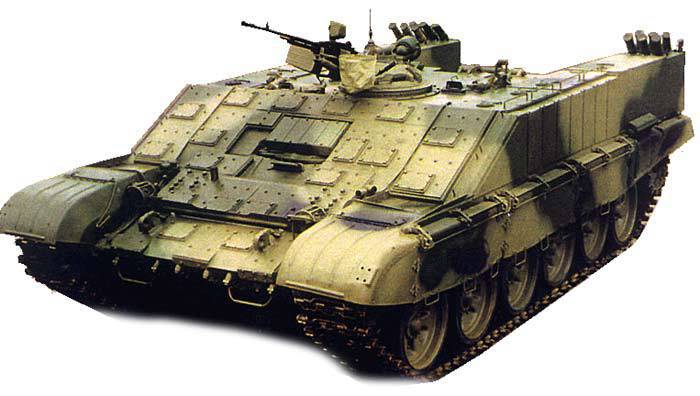
The crew and assault forces of the BMO-T vehicle are located in the total habitable volume, which does not have a clear division into the control, landing and combat compartments. In front of the case, in the old place, is a driver. Directly behind him is the place of the commander of the machine, also acting as the shooter. Along the hull sides in the side and behind the commander there are seven seats for the landing. On the left side there are three seats, on the right - four.
On the frontal part and the roof of the case, three groups of optical instruments are provided for monitoring the environment. The driver uses four devices, the commander - three. A few more periscopes installed in the roof above the places of paratroopers. In this case, however, the landing can observe, but does not have the possibility of firing from personal weapons. Due to the specific spaced booking of the sides, the car is not equipped with loopholes.
In addition to personal small arms, the Flamethrower paratroopers have 30 rocket flamethrowers RPO-A Bumblebee. This weapon is placed on three racks of a special design. Flamethrowers are transported in a vertical position and fixed in order to avoid falling from the rack. One of the shelves for the "Bumblebees" is located in the middle of the hull, between the landing places; the second is located along the left side, in front of the seats; and the third is installed at the right side of the hull, perpendicular to the axis of the machine. According to some information, an additional compartment for the transport of flamethrowers is provided in the fencer shelves.
The crew and assault force of the BMO-T flamethrower combat vehicle has a set of hatches for landing and leaving the vehicle. The driver's hatch is located in the characteristic recess of the frontal part of the hull and superstructure. On the roof, under the machine gun turret, there is a hatch commander. To the right and to the left, behind the turret, two more hatches are provided, which the paratroopers can use. There are two main hatches for the landing of troops in the rear of the superstructure. The aft sheet of the superstructure is angled, and the manhole covers are made in the form of a triangular (when viewed from the side) structure, because of which, when closed, turn out to be a small continuation of the roof. During the landing, the hatches are raised and secured in a vertical position, providing additional protection for the fighters.
To leave the BMO-T vehicle, flamethrowers must open the feed hatches of the habitable volume, go to the roof of the engine compartment and, after passing through it, descend to the ground. For greater convenience on the side screens of the body, in the middle part of it, there are loop-steps. At the rear of the hull are folding steps. The layout of the habitable compartment suggests that if necessary, any crew member or flamethrower can leave the car through any of the available hatches.
According to reports, the heavy fighting machine flamethrowers BMO-T was developed in the late nineties. At the same time, the equipment passed the entire test cycle, after which in the 2001, the RCBZ was put into service. Around the same time, mass production of new equipment began. There is no exact information on production methods: it is not known whether new BMO-Ts are being built from scratch or are being converted from existing T-72 tanks. According to different sources, to date, the RCBZ troops have received at least 10-15 machines of a new type. The production of such equipment continued, at least until the end of the last decade.
A number of BMO-T vehicles are currently operated by the Russian armed forces. From time to time, such equipment appears on photographic and video materials from various exercises, parades and other events in which RHBZ units take part. Exact information about the operation of such technology is not yet available.
The BMO-T heavy flamethrower combat vehicle is a very curious version of a heavy infantry fighting vehicle based on a tank chassis. Despite the specific purpose and availability of special racks for jet flame throwers, this technique clearly shows the possibilities and prospects of machines of its class. The adoption and operation of the BMO-T testifies to the fundamental possibility of creating and successfully using highly protected vehicles with fire support functions for the fighters.
Nevertheless, the BMO-T is not without some flaws that can impede the effective performance of combat missions. First of all, it should be noted relatively weak defensive weapons. Domestic infantry fighting vehicles are equipped with tools of different calibers, and large-caliber machine guns are characteristic of armored personnel carriers with slightly different tasks. Nevertheless, as shown by the project of a heavy BTR-T armored personnel carrier based on the T-55 tank, such equipment can also be equipped with combat modules with more serious weapons.
The failed BTR-T project should also be recalled in a different context. Like the BMO-T, this armored personnel carrier had landing hatches located in the rear of the superstructure, in front of the engine compartment. This feature was one of the reasons for the claims, because of which the BTR-T was never accepted for service. With this method of landing, despite the powerful armor of the machine itself, the landing does not have sufficient protection and is seriously at risk. Increasing the level of protection of the landing fighters can only be accomplished with a radical processing of the hull layout. To do this, move the engine compartment to the front of the hull, and the landing place - in the stern.
For a number of reasons, the BTR-T armored personnel carrier never left the testing stage, having failed to interest potential customers in the person of the Russian Ministry of Defense and foreign military. The combat vehicle of flamethrowers BMO-T, in turn, was put into service and built serially. Probably, in the case of the latter, the level of protection of the crew and the landing force was put at the forefront, as well as the possibility of transporting additional weapons in the form of several dozen flame throwers. Obviously, the proposed machine fully complied with the requirements of the customer in the person of the command of the RCBZ troops, which affected her fate in a positive way.
On the materials of the sites:
http://btvt.narod.ru/
http://rus-guns.com/
http://defendingrussia.ru/
http://gurkhan.blogspot.ru/
http://vestnik-rm.ru/
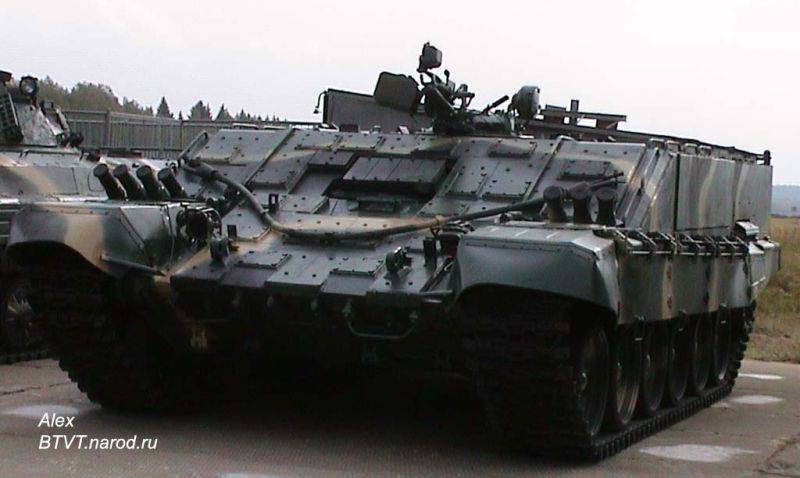
Information